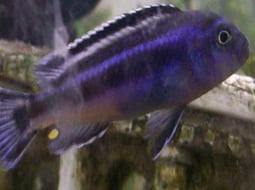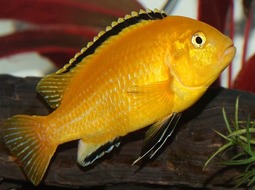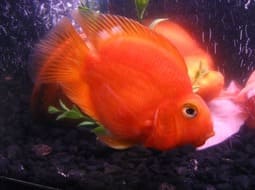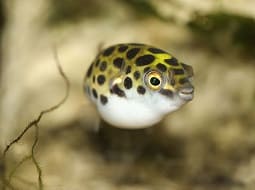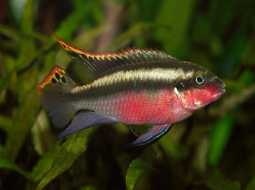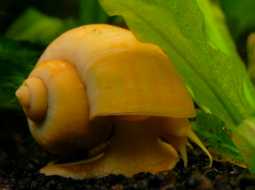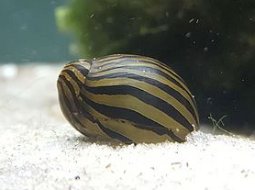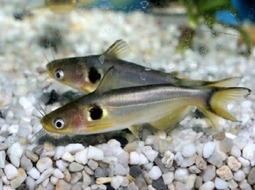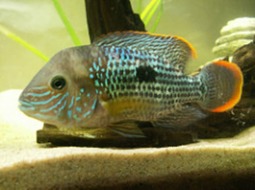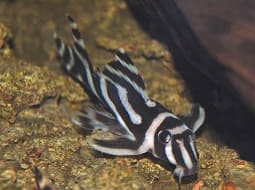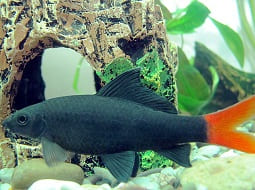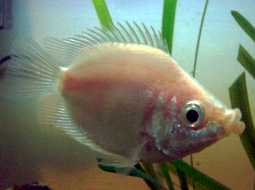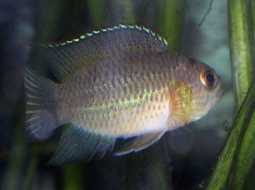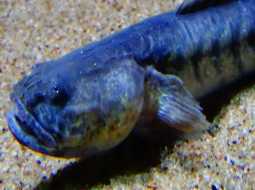
Loading Aqualapp ...
Care and Compatibility of Convict Cichlid - Amatitlania nigrofasciata
Introduction
The Amatitlania nigrofasciata, also known as the Convict Cichlid, is a species of cichlid fish found in Central America. They are moderate-sized fish, with a maximum length of around 10 centimeters. They have a robust, laterally compressed body with coloration that varies depending on gender and mood. Males usually have a pattern of black and white stripes throughout their body, while females are typically less colorful. In captivity, they are bred in a wide range of selected colors, including albino color varieties. They are known for their aggression and territoriality, especially during the breeding season. Therefore, it is important to provide them with an aquarium with sufficient space and hiding places to establish their territory and avoid conflicts with other fish. They are hardy and adaptable fish, capable of surviving in a wide range of water conditions. However, it is recommended to keep them in a clean, well-oxygenated environment with a suitable temperature. In terms of feeding, they are omnivorous and accept a variety of foods. They can be fed with specialized cichlid commercial foods, live foods, and vegetables. A balanced and varied diet is key to maintaining their health and coloration.
Behavior
The Amatitlania nigrofasciata, commonly known as the Convict Cichlid, is a species of cichlid fish native to Central America. They are territorial and aggressive fish, especially during the breeding season. In the wild, they are found in warm, well-oxygenated streams and rivers. In captivity, they are popular among aquarium hobbyists due to their attractive colors and interesting behavior. They are intelligent and active fish and can form bonds with their caretakers. However, their aggression and relatively small size require them to be kept in adequately spacious aquariums with enough hiding places to avoid conflicts with other fish. They are omnivorous and accept a variety of foods, including commercial foods, live foods, and vegetables. It is important to provide them with a balanced and varied diet to maintain their health and coloration.
Sexual Dimorphism
Sexual dimorphism in Amatitlania nigrofasciata is minimal and difficult to distinguish. Both males and females have a similar appearance. During the breeding season, they may exhibit more pronounced territorial behavior.
Reproduction
The Amatitlania nigrofasciata is a fish that reaches sexual maturity at a relatively young age. They are prolific breeders, and it is common for them to breed in captivity. During the breeding season, the pair will form a bond and defend a territory for spawning and raising fry. The female will deposit her eggs on a flat surface, such as a rock or a plant leaf, while the male follows to fertilize the eggs. After spawning, both the male and female will take care of the eggs and fry. They will protect the territory and defend the offspring from potential threats. The fry will grow rapidly and can be fed with food for small fry and live microorganisms. It is recommended to provide them with a separate breeding aquarium to ensure the survival of the fry and prevent predation by other adult fish.
Aquarium Conditions
Amatitlania nigrofasciata, commonly known as convict cichlid, is a Central American cichlid that requires an aquarium with rocks, driftwood, and hiding spots. It prefers neutral to slightly alkaline water and warm temperature. Aquarium décor should provide enough structure and hiding places. Maintaining water quality is important and providing a varied diet.
Feeding
The Amatitlania nigrofasciata is an omnivorous fish and accepts a variety of foods. They can be fed with specific commercial cichlid foods, such as high-quality pellets or flakes. They also accept live foods such as worms, brine shrimp, and insect larvae. Additionally, vegetable foods such as spinach, peas, or dried algae can be offered to them. It is recommended to provide them with a balanced and varied diet, avoiding excessive fatty or animal-based foods. They should be fed twice a day in portions that they can consume within a few minutes.
Complexity
Caring for Amatitlania nigrofasciata is relatively straightforward. They are hardy fish that adapt well to a variety of water conditions. However, they may show aggression towards other fish, especially during breeding and territory protection. It's recommended to keep them in pairs or groups with enough space and hiding spots.
In case you need more help, or if you want to know into any topic related to the Amatitlania nigrofasciata (Convict Cichlid) and even any other species you can use the forums to ask what you need.
To do an analysis more detailed about coexistence and behavior of Amatitlania nigrofasciata (Convict Cichlid) use the Aquarium simulation tool, if you do this you can test different ways to combine the Convict Cichlid with other fishes giving the dimensions and space on you aquarium, on this way you can known the optimal configuration for keep the fishes that you want.
You can also find out the 42 species compatible with the Amatitlania nigrofasciata (Convict Cichlid) can live together.
Note: The parameters of the water such as PH and temperature are also used to calculate the compatibility of the species.
Compatible species (42)
Compatible (13 Species)
Compatible without any restriction
Similar Sizes (1 Species)
They can coexist if they are the same size or very similar sizes, it does not work in all cases, there may be exceptions.
With Reservation (11 Species)
Las especies territoriales por lo general pueden convivir con especies protegidas con coraza, ya que no pueden hacerles daño por su dura piel, lo que si hay que tener en cuenta es tener un acuario con dimensiones favorables para que cada pez pueda delimitar un territorio, ya que la mayoría de peces acorazados son también peces de fondo y les gusta estar buscando lugares donde ocultarse.
Compatible in some cases, it depends on the nature and personality of the fish.
Showdown over territory (4 Species)
Fish can live together as long as the space is spacious enough to delimit a territory, otherwise there may be aggressions for competing for the territory.
Considerable size difference (4 Species)
They can coexist while they are similar in size or the size difference is not very abysmal, since as the fish grows it increases the chances of eating its partner that did not grow much.
Compatible if space is enough (9 Species)
They can coexist together if the aquarium they share is large and spacious enough for both species to feel good, as some fish may attack others to feel that they have little space and try to eliminate the competition.
Convict Cichlid
Amatitlania nigrofasciata
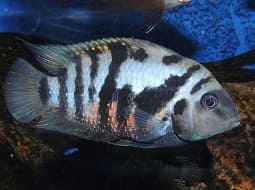
- Ph: 6.5 - 8
- Temperature (c°): 20 - 24
- Measures: 12 cm - 15cm
- Aquarium Capacity:
60 Liters - 16 Gallons - Alimentación: Carnivores, Omnivores
- Colores: Black, Blue, Gris, Orange
- Comportamiento: Semi Aggressive, Territorial
- Habitad: American
- Preferencias del Acuario: Logs, Rocks
- Tamaño: Medium
- Taxonomía: Cichlids, Fish
- Tipo de Agua: Sweet water, Tropical waters
- Velocidad de nado o movimiento: Normal
- Zona de Nado: Swim in the middle of the aquarium

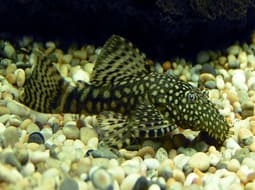
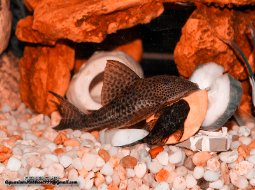
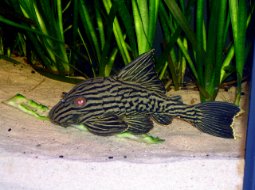


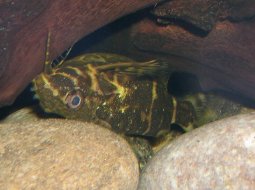
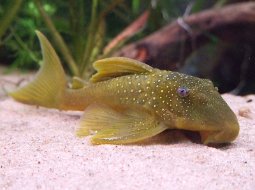
.jpg)

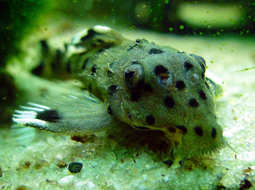
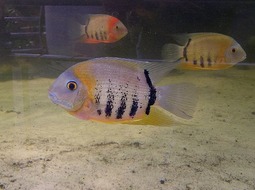
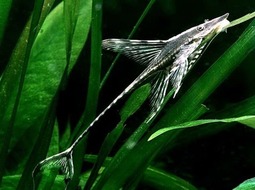

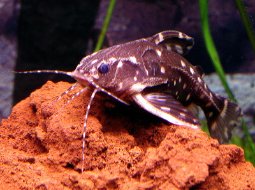
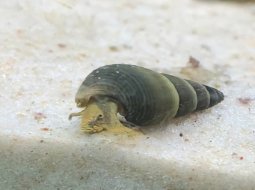

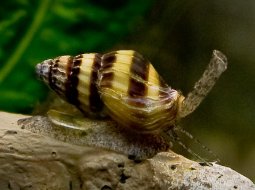

.jpg)
